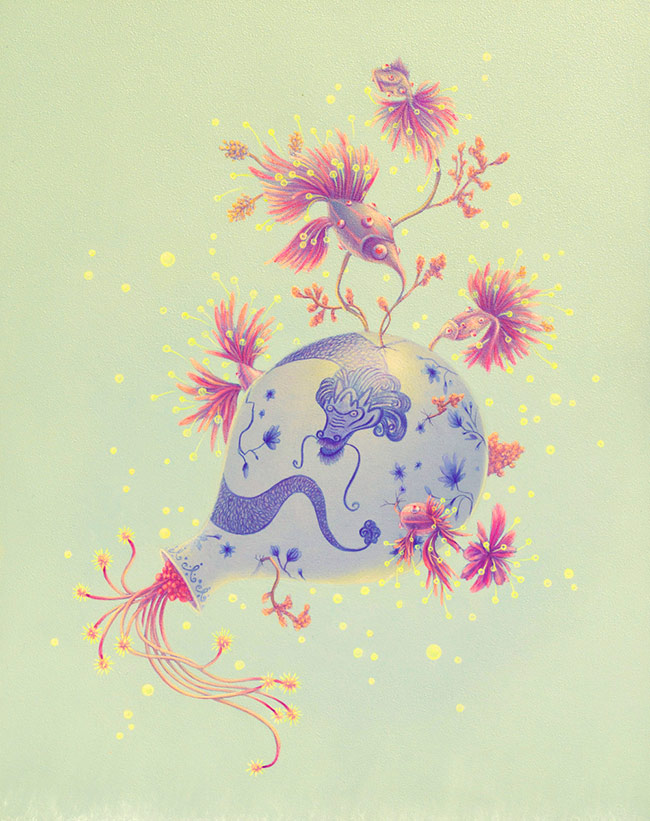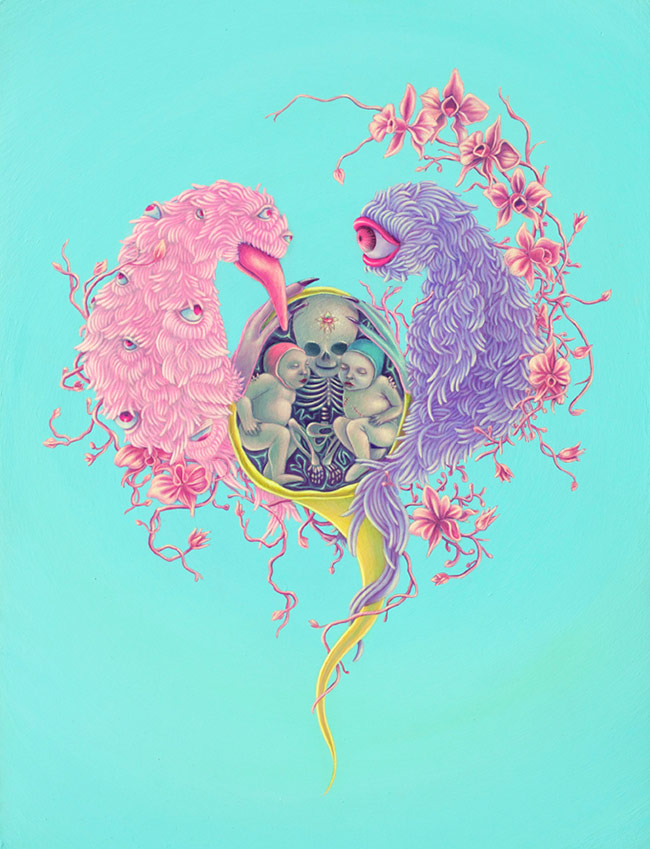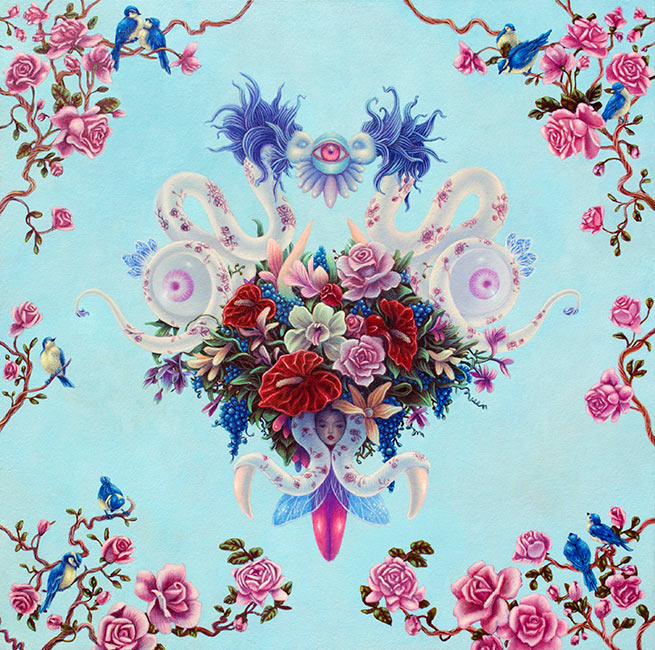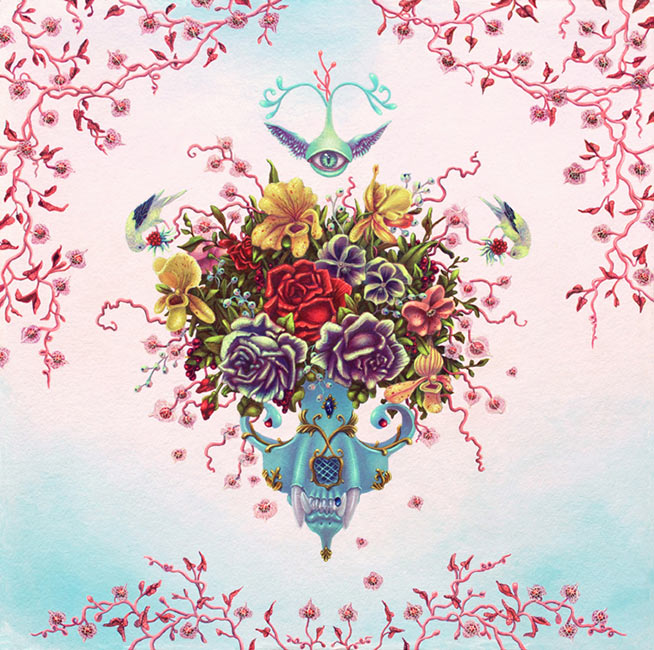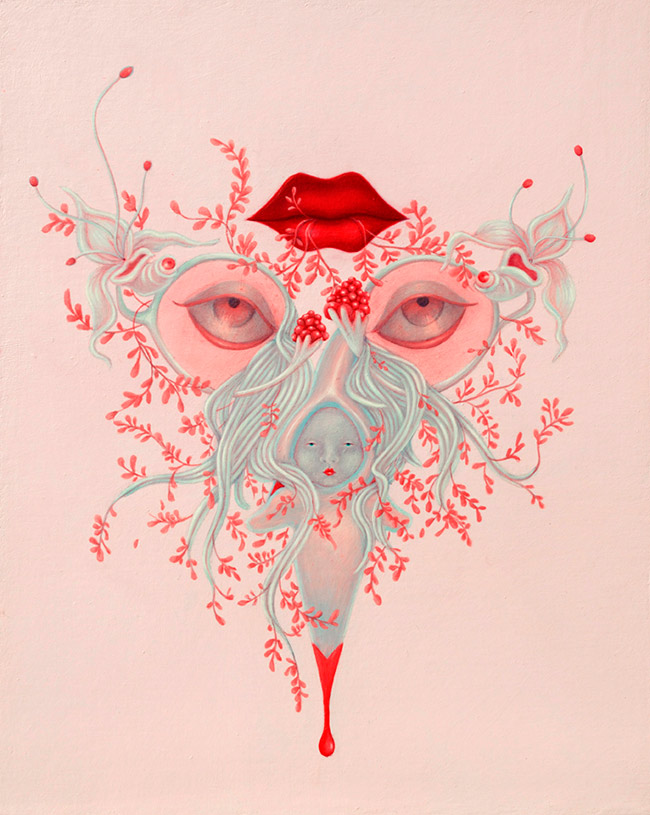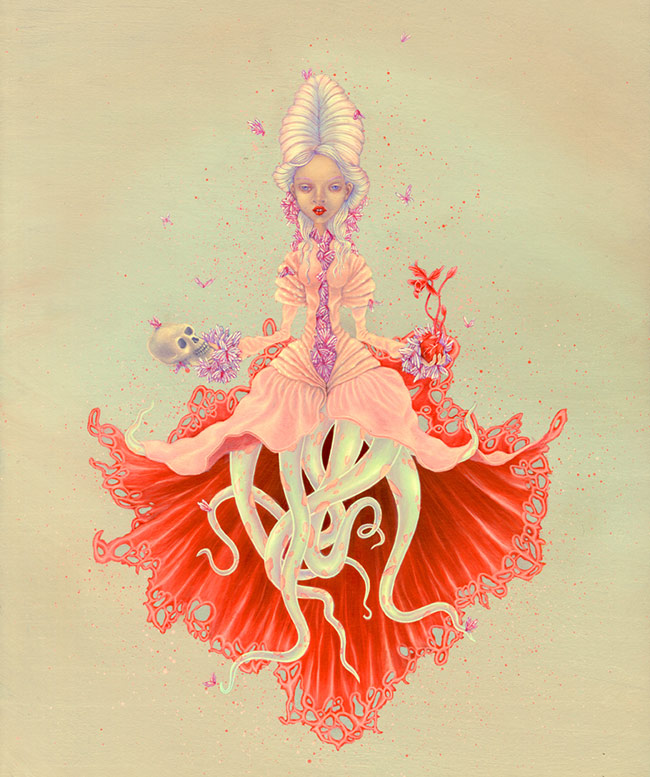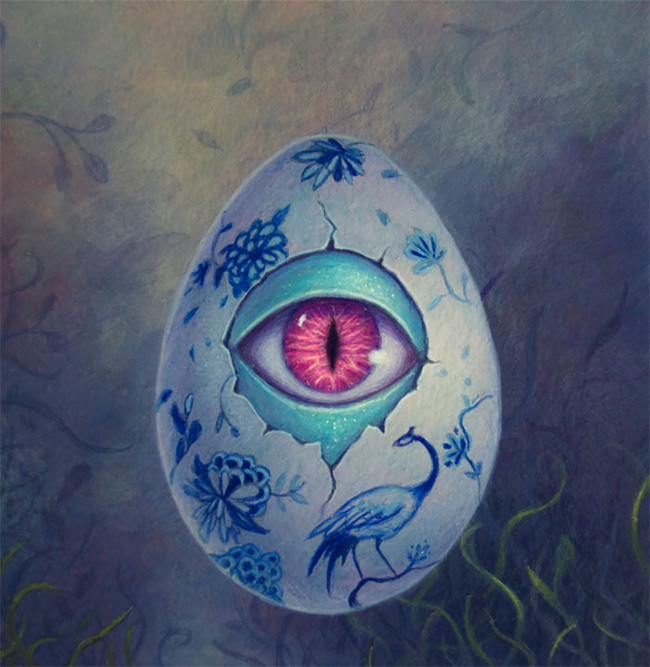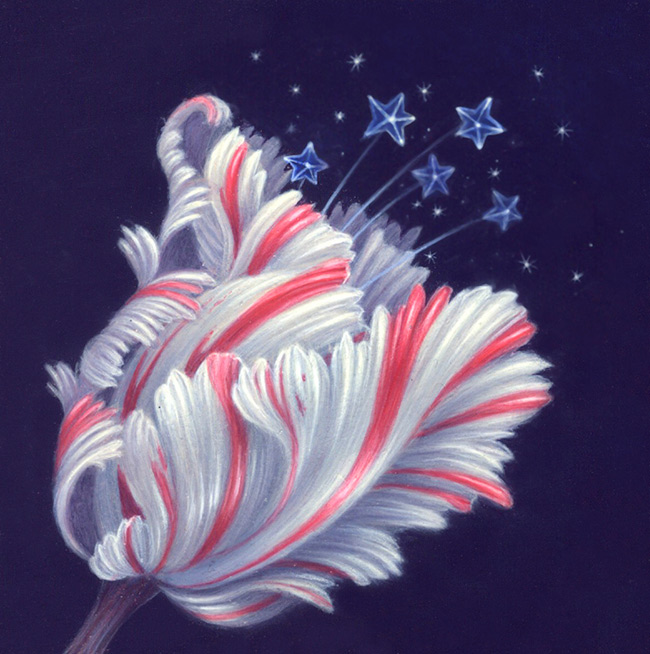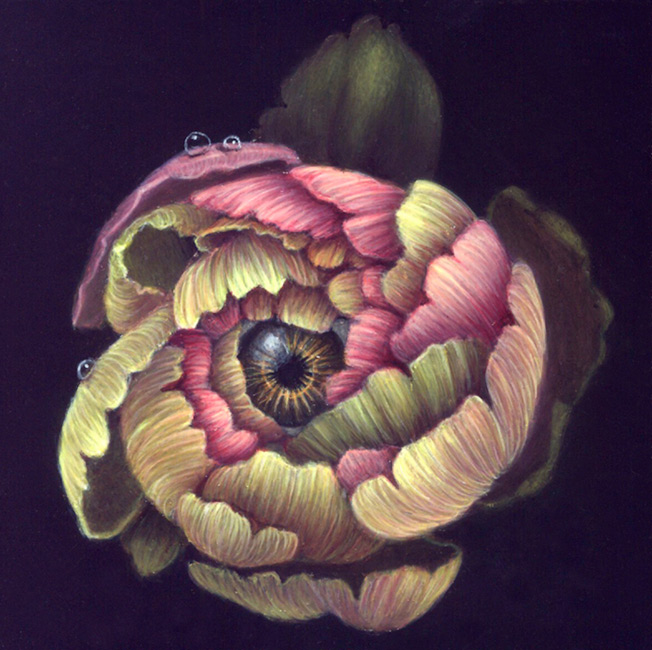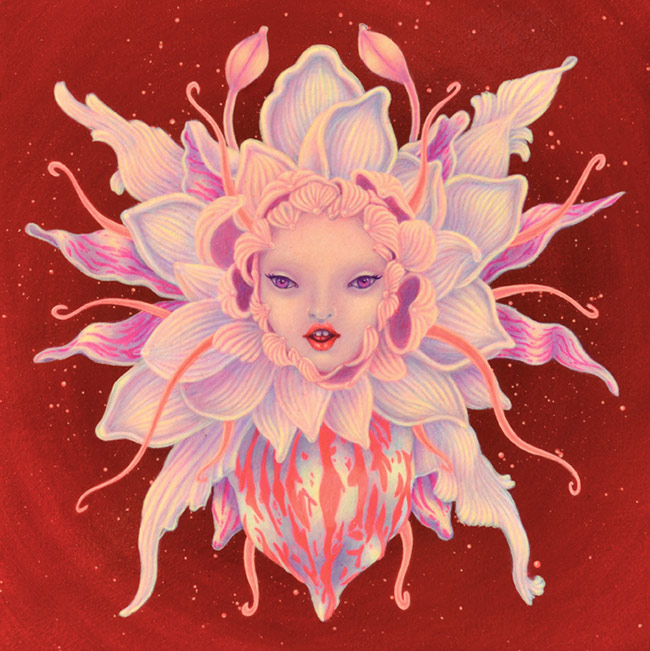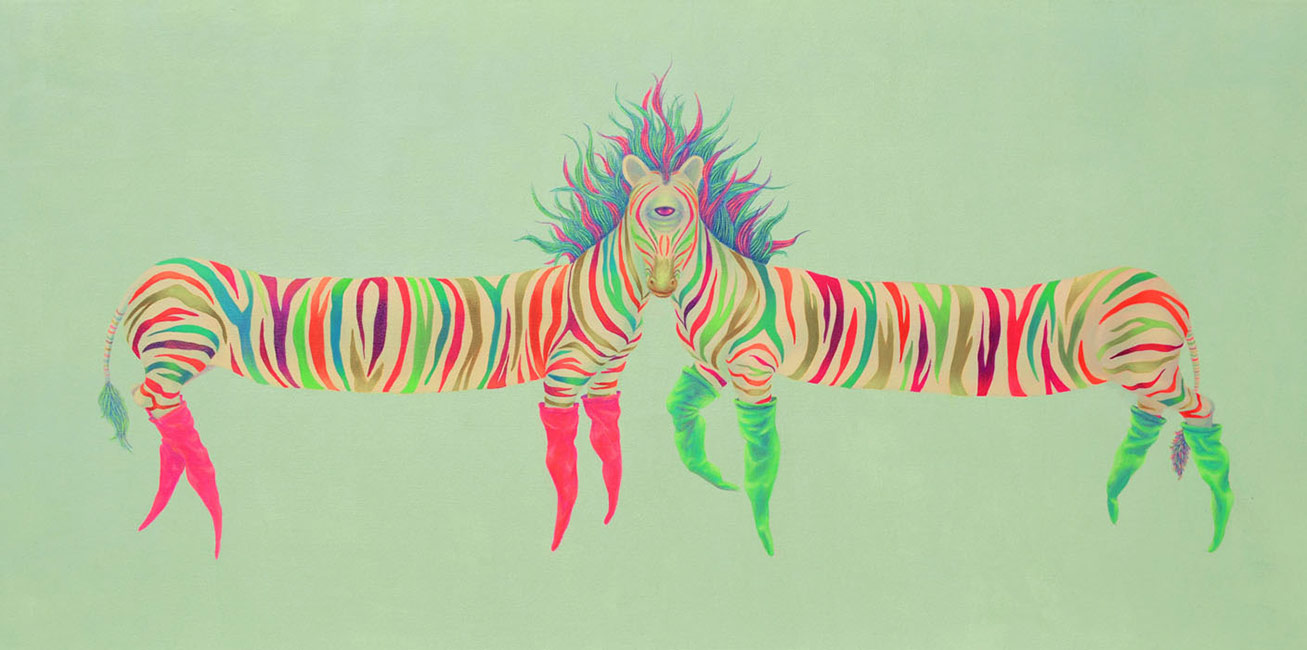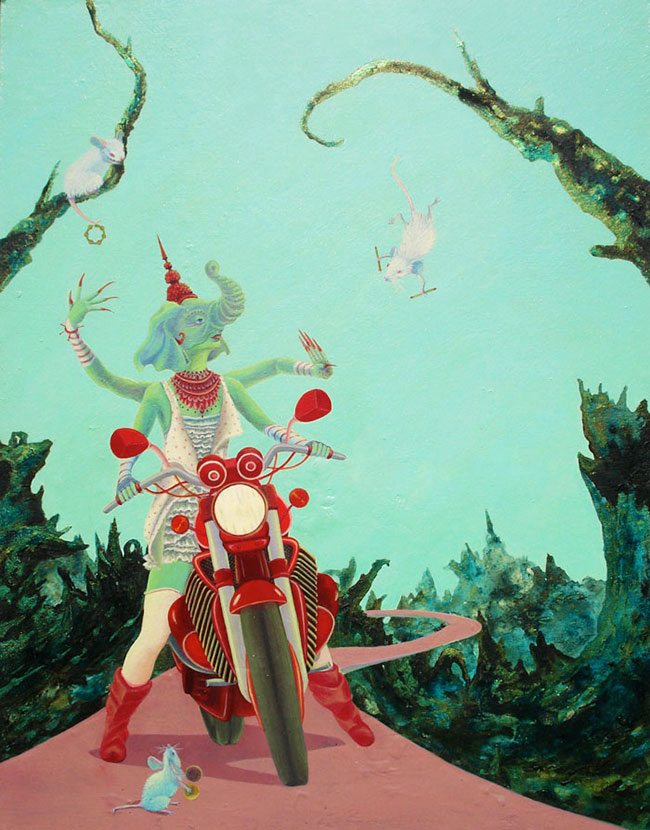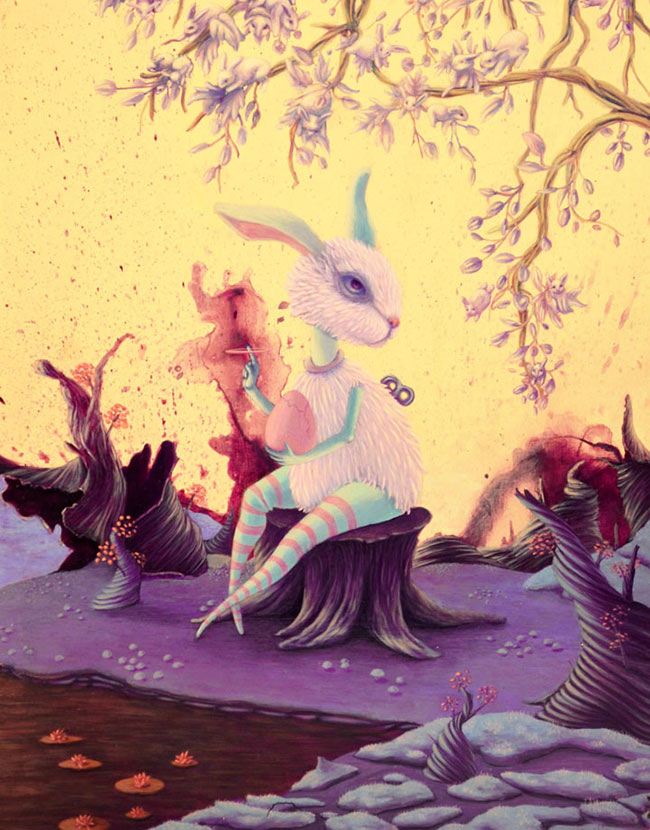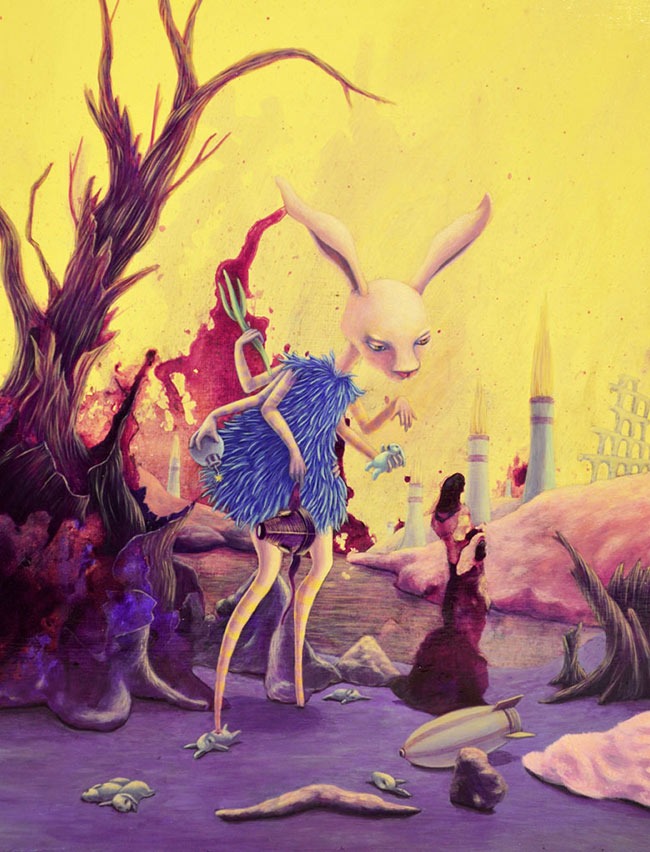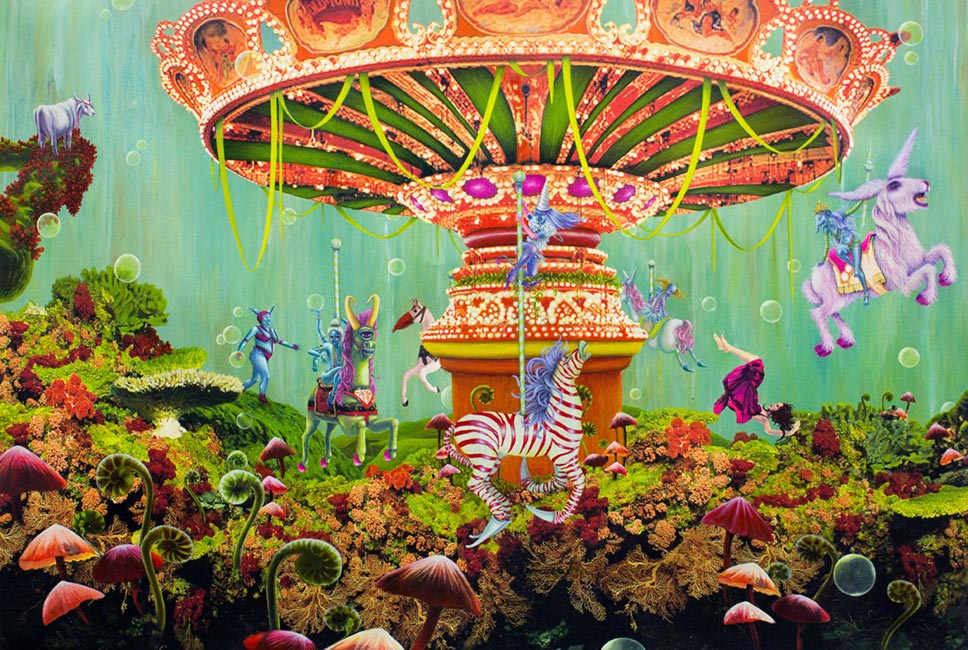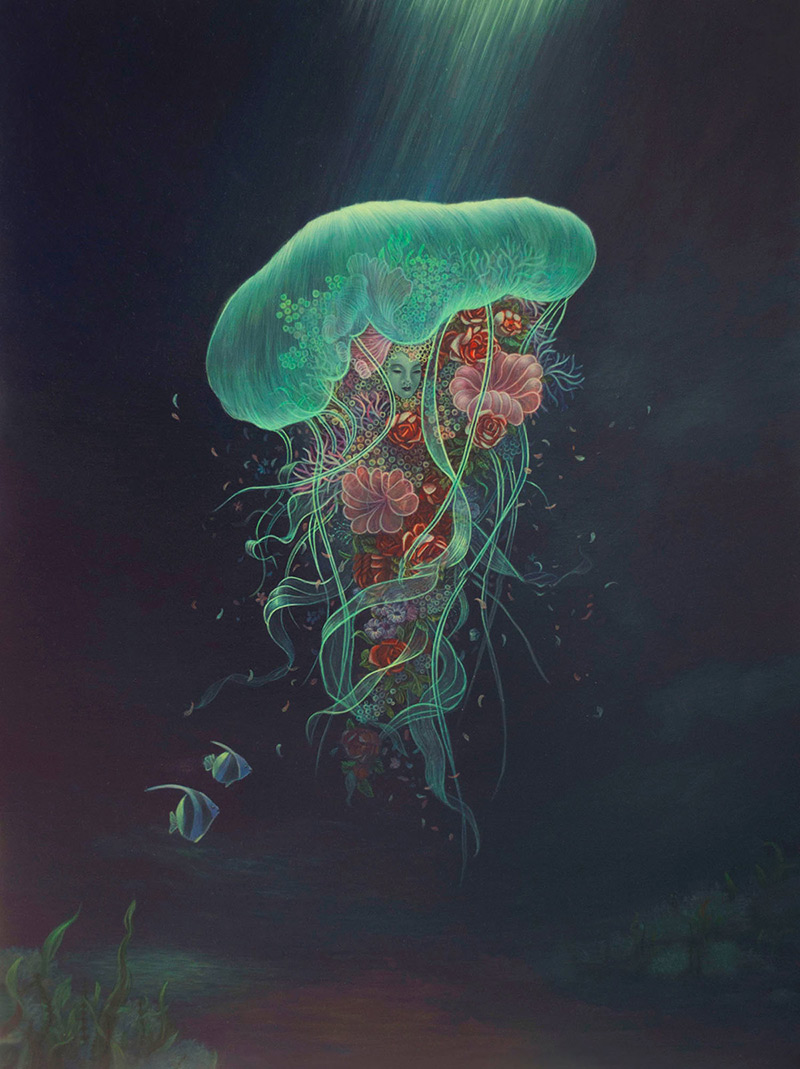Edith Waddell’s captivating paintings masterfully expound themes of duality with a strong focus on the exploration of those instances where our internal worlds meet and merge with the external universe. Incorporating a vast and at times deeply personal library of symbolic cues revolving around the language of dreams and her love of nature, Waddell constructs her own elaborate maps of the psyche and its relationships with, and the reciprocal influences of, the corporeal and incorporeal planes of existence. One of the great strengths of Waddell’s beautifully realised imagery lies in its power to elicit reactions that are both challengingly cerebral and profoundly visceral, as through her striking visions she taps into a wellspring of meaning that connects with our cores on emotional levels that our conscious (and unconscious) minds work on unravelling over time.
Edith Waddell was born and raised in Arequipa, Peru and has been living and working in Los Angeles since 2002. In 2012, she graduated from Otis College of Art and Design with a BFA in Illustration and she currently works as an exhibiting fine artist and freelance illustrator.
WOW x WOW is both extremely thrilled and honoured to have a new painting by Edith, entitled, ‘Memoirs of a Sea Geisha’, in our current ‘Lightning Bolts & Little Sparks’ exhibit. So, what better time to have a chat with this talented artist and get a fresh insight into her creative thoughts and inspirations. Read on!
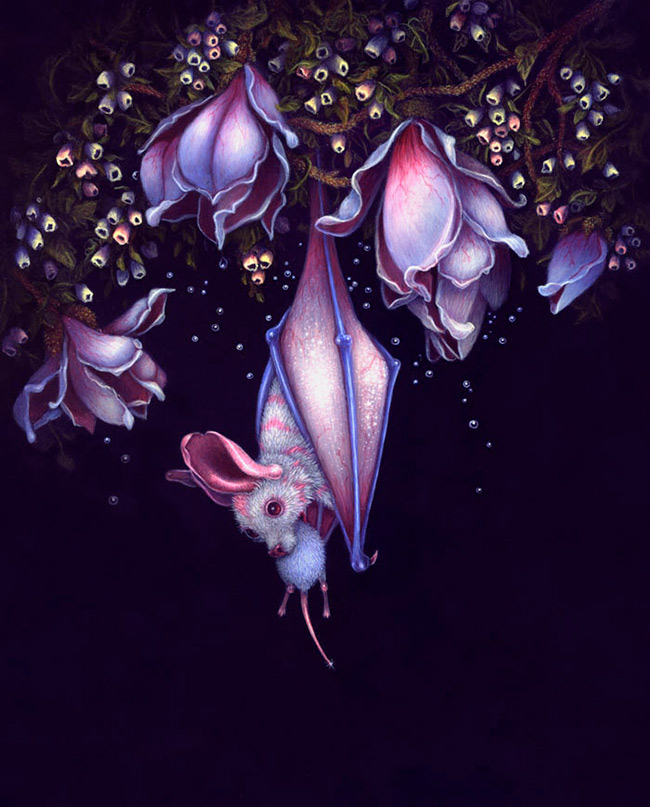
Hi Edith, thanks very much for making the time to have a chat, we really appreciate it. To get us started, can you give us some background on what has lead you to this point in your professional life, be it your formal training, serendipity, etc.?
I was born in Peru, where my mother and father were both evangelical missionaries at the time. As a child, I grew up surrounded with musical instruments, gospel songs and an emphasis on rigorous discipline in all walks of life. I felt the allure of the arts, both performing and plastic, from my early childhood on. In my early twenties, I became part of an experimental theater company in my hometown, which gave me a chance to explore poetry, dance, singing and dramatic performance. I moved from Peru to Los Angeles in 2002, where I studied nursing, but I felt very constrained and out of place working in a hospital environment. So, I decided to follow my heart, and I managed to get accepted into art school, where I majored in Illustration.
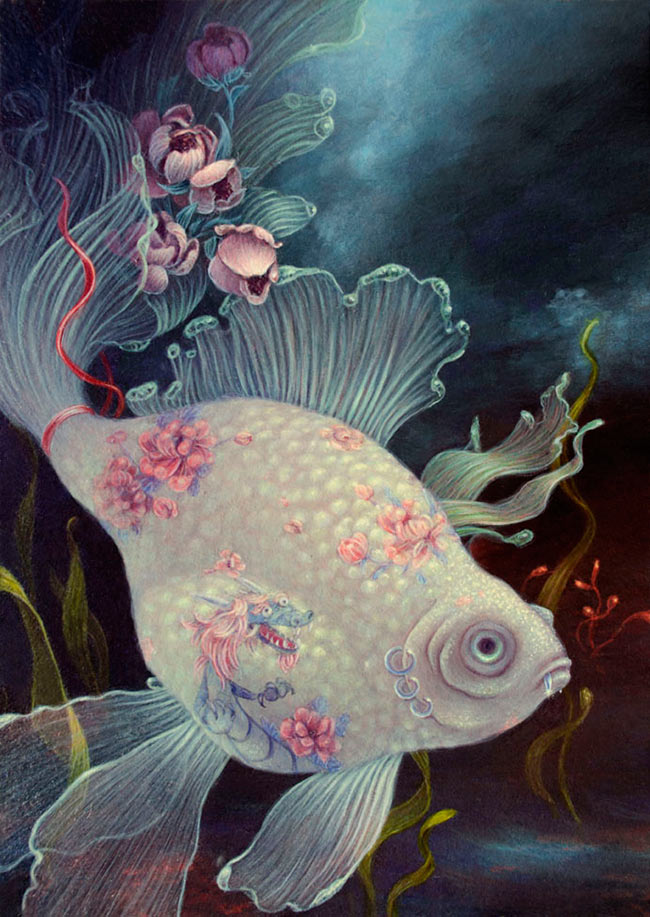
We’re interested to hear about where you’re currently living and what you like about the area? What is the art scene like there and do you feel a part of that community? Are these aspects of your life that are important to your creativity?
Los Angeles is known for its thriving film and music industries, and it also has a very strong and vibrant art scene. The city is unique in terms of its history, geography, and cultural diversity – almost every corner of the globe is represented here. For an artist like me, it’s like being surrounded by a vast and diverse pantry of ideas and curiosities to explore and integrate into my own artistic expression. Much of the time, my life revolves almost 24/7 around my own painting, which is very gratifying, but can also be isolating in many ways.
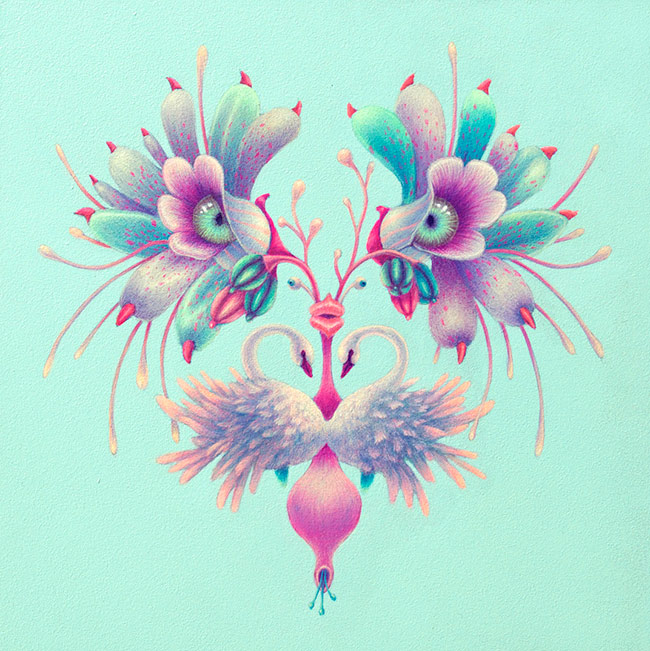
In what ways did your childhood and upbringing affect your relationship with the arts?
I was an only child, in a missionary family, so my childhood was pretty solitary. I spent a great deal of my time alone in the back garden at home, playing with my imaginary friend under a fig tree, and at times drawing on any white space I could find – on the blank pages of bibles, encyclopedias, dictionaries, whatever was available. When I was five years old, one of my favorite hobbies was to flip through the pages of our illustrated set of encyclopedias, and one day I saw there a picture of ‘The Burning Giraffe’ by Salvador Dalí. I was so mesmerized by that image that I couldn’t stop going back to see it again and again, then and for many years after. In my five-year old mind, I wasn’t sure whether this was fantasy, or if a woman who looked like that could exist in real life. I wanted more than anything to grow up one day looking as weird and beautiful as that surreal, elongated, flesh-and-wood woman.
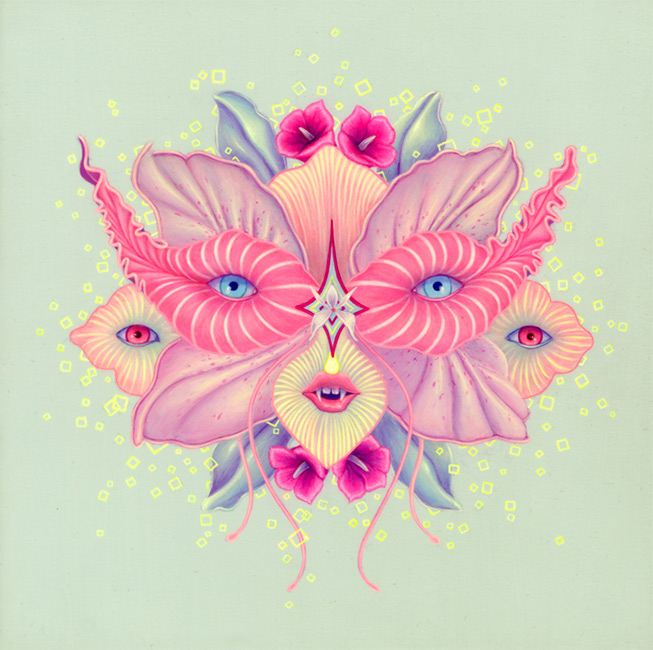
There is a distinct duality at play within your imagery. Light and dark; life and death; whimsy and seriousness. What interests you the most about opposites and how do you approach the balancing act which exists between them?
I think there is a natural human tendency to perceive and classify the world as right and wrong; benevolent and malevolent; moral and amoral, and so on. Although the world is not exclusively binary in all things (in everything there is always a gray area), it intrigues me to see the balancing effect created by antithesis, in which counterparts are in a constant and complementary interaction. I like playing with concepts that mutually seem to contradict one another; the balance between spirituality and biology, the contradictions of a complex inner self; these things are of much interest to me nowadays. For instance, in Hinduism, the deity Shiva destroys in order to open a path for further creation. I love the duality of that.
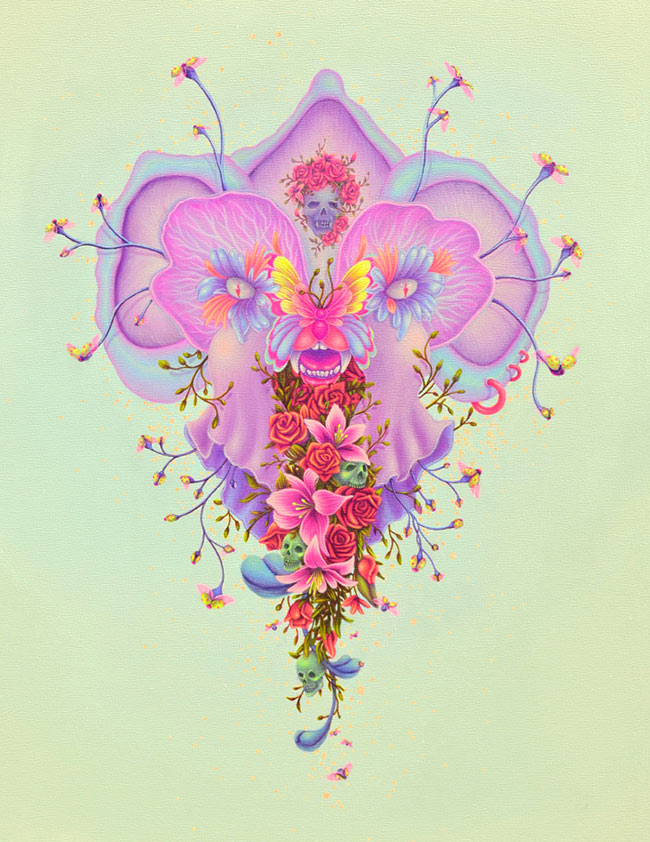
We’d love to hear you talk about the symmetrical aspect of your imagery. What is it that particularly fascinates you about the balance and harmony of this visual equilibrium and how do you like to think about it in relation to your paintings? When did you begin experimenting with this particular stylisation and how have you developed it over time?
In my creative process, I feel that combining contrasting ideas helps me to create a singular reality that represents a struggle of opposing elements to co-exist harmoniously. The recurrent symmetrical aspect of my imagery is something that emerged a little bit at a time over the years, without a conscious effort on my part. I believe that it came as a manifestation of a pivotal period in my life, in which I went through deep depression and was prone to self-destructive behavior. During a psychological intake session, I was given a Rorschach test, and I was fascinated by the inky, dark, grotesque imagery. Its ambiguity left infinite possibilities for me to interpret. That might be at the root of why I’ve evolved such an inkblot-like, symmetrical style. Symmetry is visual equilibrium, but it also represents an interplay of counterparts. “As above, so below.”
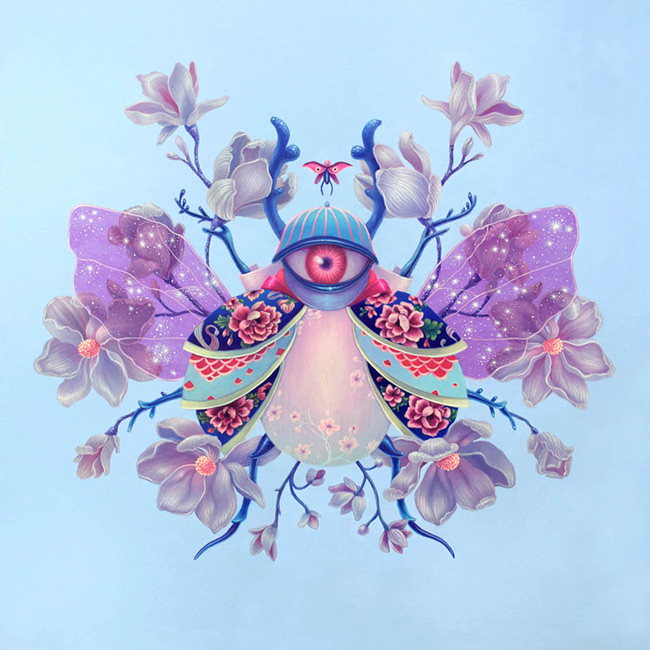
Tell us a little about the symbolic content of your work and whether you place any importance on creating our own symbology or if you prefer to tap into the power of more universal symbolism?
I think it’s a little of both, and they overlap. A lot of the content and meaning of my imagery come from my own internal universe of dreams, fears, longing, and memories. As with many women, the possibility of childbirth has been a source of great yearning and anxiety at the same time for me, so the theme of reproduction recurs in a lot of my paintings. As I paint, I spend a lot of my time listening to documentaries about world history, ancient and modern mythology, folktales, anthropology, archaeology and animal/plant symbolism, and I’m sure that much of what my brain has retained from all of that listening has made its way into my work. I see my anthropomorphic floral bouquets as visual labyrinths that are designed to draw viewers in, where hopefully they’ll find a reflection in the symbols there of the dualities in their own lives.
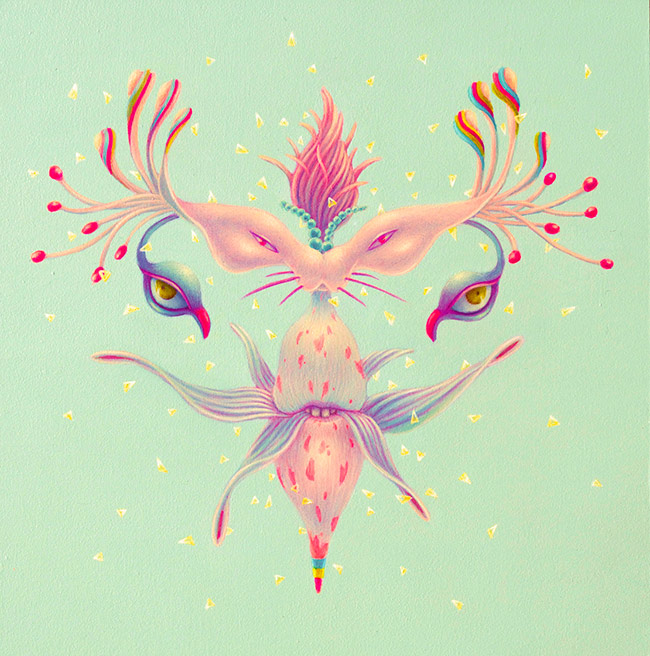
Your artwork explores instances of our internal worlds meeting and merging with the external universe, encouraging the examination of our existence from both physical and spiritual perspectives. Would you be willing to comment on the accuracy of this statement and either correct or expand on its sentiment?
Yes, that’s pretty accurate. And in considering the spiritual side of that, I am including the supernatural. Consciously or not, there are some memories that we have or beliefs that we carry, often from childhood, that are obliterated or rationalized by our minds in order to cope with reality, or in order to avoid ostracization. Those hidden memories and suppressed beliefs can emerge later on in subtle or flamboyant ways. For instance, I have a very clear memory of encountering a foot-high, very angry gnome, after overturning a rock in my garden, when I was a small child. As an adult, my rational thinking reconciles the memory of that experience, and other similar ones, as symptoms of a kid’s hyperactive imagination. However, sometimes I reflect on those memories, and I wonder, what was that, really? Does a supernatural, spiritual world really exist? And if it does, can it intersect with our physical reality in ways that are concrete? If they’re real, how do I reconcile my rationalist adult self with experiences that defy explanation? One of the things my paintings reflect is this clash of belief and skepticism. They are visually balanced images that appear harmonious, but are conceptually inspired by dichotomy.
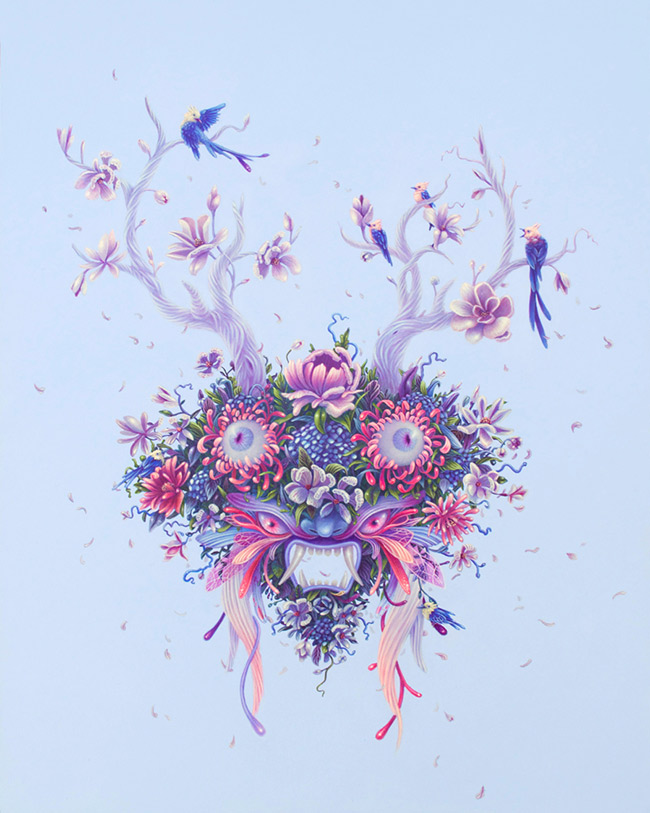
In your Artist Statement you say that your “goal is to make visible that which is overlooked, confronting the public with the dark and mysterious aspects of their own psyches, emotional struggles, and their relationship with the natural environment.” With this in mind, to what extent do you consider the viewers of your work during its creation and what are your thoughts about the conversation cycle which is created between the artist and audience?
When I start to create or sketch something, I don’t worry too much about whether or not people will be able to understand or feel moved by what I make. In the creative process, I think it is better to please myself rather than trying to adjust my work to the imagined expectations of others. Some people have told me that they don’t necessarily like what they see in my work, but that at the same time, somehow, it speaks to them on a very intimate level, although they may not know why. Whether a person likes my art or not, that is the type of interchange that I wish to happen between my art and the beholder; an interaction that might not be fully understood, but is strongly felt. I think universally everyone keeps or has kept skeletons in the closet. Many people deal with irrational fears, PTSD, suppressed traumatic memories, and so on. Those situations are too difficult for them to talk about openly. We all carry within ourselves some thoughts and ideas, which are too grotesque or too uncanny to be discussed in public, so in part I’m trying to give symbolic voice to that notion in my work.
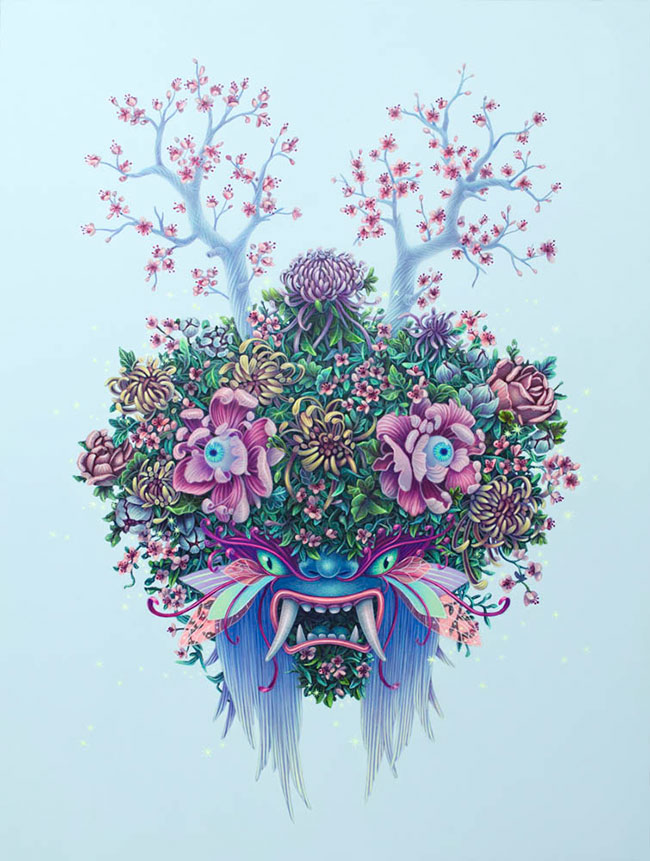
Where does your focus lie when you’re painting?
I become extremely focused on the very small details, sometimes too much so. I’m obsessed with good shading and modeling on the micro scale, as well as transition of color. It can slow me down a lot, though, so I’m trying to move on more quickly nowadays, when I get stuck on minutiae.
In order to get a better understanding of the personality of an artist, it can help to get a peek behind the curtain. Would you be willing to share a story from your own life, possibly one whose memory you find yourself returning to for inspiration, or maybe just a tale about a hardship you’ve overcome which has helped define the person and therefore artist that you are now?
In my teenage years I helped my mom at her floral design shop, making floral arrangements for events like weddings and funerals. There, I learned about flower symbology, and that’s also where I developed my obsessive attention to detail. I also learned to keep clients’ love secrets, and by request I would sometimes write love notes on their behalf as well. It was hard and tedious work that I sometimes hated, but now I remember it with fond nostalgia. I am pretty sure that’s the reason for the recurrent flower imagery in my work.
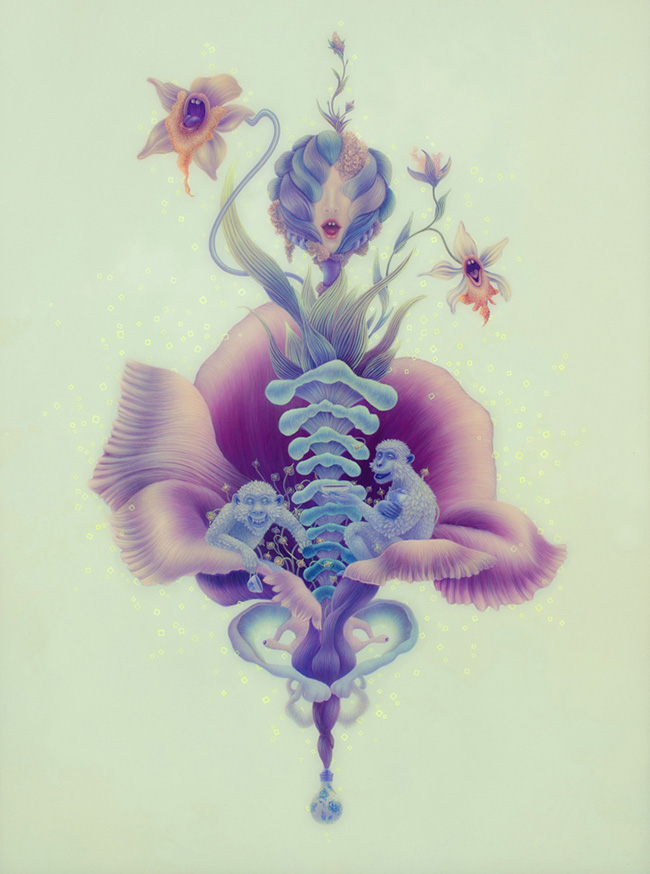
If you could own one piece of art from any of the world’s collections what would it be and why?
I would own ‘The Burning Giraffe’ by Dalí because it is a visual personification of the inner self, and the subconscious with its secret drawers waiting to be opened and explored.
What’s next for Edith Waddell?
I am not sure what will happen tomorrow. I live in the moment with the little challenges and triumphs of everyday. But I think that in the fairly near future I would like to get out of my comfort zone and into something unfamiliar and intimidating to me, such as animation, or digital painting.
